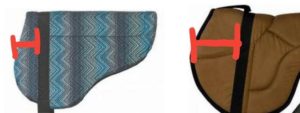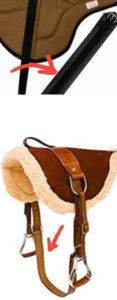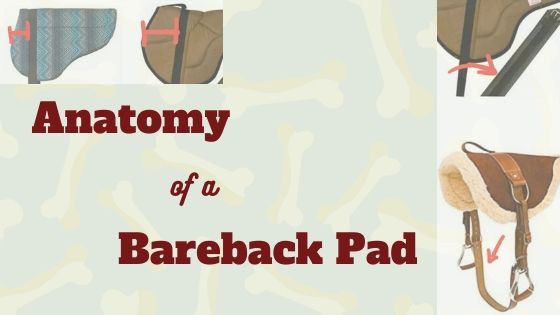Bareback pads are a very common piece of tack utilized in the Equine Assisted Activities and Therapies (EAAT) world and there are many different types and styles available.
It is important for instructors to understand that not all bareback pads are created or designed equal and for them to recognize the different components of a bareback pad’s “anatomy” that can impact it’s quality and usefulness.
The “anatomy” of a bareback pad can greatly impact the comfort of the equine, the comfort and position of the rider, and whether or not the pad stays in proper position on the equine.
So how do you determine if a bareback pad has good “anatomy”? Let’s take a detailed look at the following points:
- The location of the girth strap (the strap on the pad that attaches to the girth)
- The width of the girth strap
- The width of the girth
- What material the pad is made from
- Stirrups on the pad
Instructor Chat Replay!
Assessing the Anatomy of a Bareback Pad
Location of the Girth Strap
 This is the first thing I look at when choosing a bareback pad. I like to have several inches of pad in front of the girth strap area. This helps to keep the pad in place and also gives the rider a visual of where to sit on the equine.
This is the first thing I look at when choosing a bareback pad. I like to have several inches of pad in front of the girth strap area. This helps to keep the pad in place and also gives the rider a visual of where to sit on the equine.
Common problem: Strap too far forward– If the strap is too far forward you may see the following problems arise:
- The pad slips back so that the entire pad is well behind the horse’s shoulders and wither.
- The shifted pad may then cause:
- The rider stays sitting in a good location on the horse but is then sitting on the front edge of the pad which is not very comfortable and may press into the rider’s legs and/or horse’s back.
- The rider may try to adjust their position back on the horse in effort to stay central in the pad area. This can cause the rider to get frequently “left behind” the movement of the horse and/or have a harder time balancing since they are not over the center of motion. The rider sitting further back can also cause discomfort or stress to the horse’s back since the rider is not over the center of motion and they are sitting over the weaker and less supported area of the horse’s back (lumbar area)
- A strap too far forward may also cause over tightening of the equipment because the instructor is trying to fight physics and keep the pad in place even though the “anatomy” of the pad and the anatomy of the horse are working against each-other.
Thickness of the Girth Strap
Unlike saddles, bareback pads typically do not have any structure or material that helps to distribute the pressure applied to the girth (the pressure aids to keep the equipment in place!). Because there is no additional structure (like the tree of the saddle) to help distribute the pressure across the pad, the pressure mostly spreads out only over the thin area of the girth strap on the pad and the girth.
 Common problem: Strap too thin- Think about wearing a belt, backpack strap, or other strap that bears weight or pressure…..the thicker the strap is the more comfortable it is and the less it cuts into your body. We can apply this same line of thinking to the girth strap.
Common problem: Strap too thin- Think about wearing a belt, backpack strap, or other strap that bears weight or pressure…..the thicker the strap is the more comfortable it is and the less it cuts into your body. We can apply this same line of thinking to the girth strap.
If possible, opt for a thicker strap that goes around the pad so that the pressure is distributed over as much surface area as possible. I’ve seen a few pads that have two girth billets on each side. This “anatomy” feature helps to distribute the pressure across the pad.
Girth- Keep or Swap?
 Depending on the “anatomy” of the pad a western or dressage style girth can be used. It seems that most pads on the market right now take western style girths.
Depending on the “anatomy” of the pad a western or dressage style girth can be used. It seems that most pads on the market right now take western style girths.
Common problem: Poor Quality Girth– Some bareback pads come with a girth…but just because a girth comes with the item it does not mean that you should necessarily use it. Most girths that come with the bareback pad are not very wide and thus risk cutting into the horse once everything is on and snugged up.
Consider the “anatomy” of the girth you are using in addition to the pad. I often swap out the girth that comes with the pad for a standard western or dressage girth that is well constructed and comfortable for the horse.
What is the pad made from?
Bareback pads are made from different materials and layers. I like to use pads that are made from materials that:
- Are easily cleaned- Can the pad be brushed, wiped, or rinsed off? I teach adaptive riding lessons to students with special needs as well as traditional lessons to young students. Due to the populations I work with my students may accidentally drool, sneeze, or heaven forbid get sick to their stomach while riding on the bareback pad.
- Can conform to the equine’s back- Is the pad able to somewhat conform to the horse’s back or is it too stiff due to the material, padding, and/or stitching and does not fit comfortably or stay in the appropriate location?
- Does not “grab” dirt, hay, shavings- is the material super soft and comfortable….but then grabs onto every piece of hay and shavings that is in the general vicinity of the pad? Pads that “grab” onto these things can get very itchy, pokey, and uncomfortable for the student and horse.
Knowing what a pad feels like or how it fits can be difficult to do until you actually feel it and see it on a horse in person.
Does the pad have stirrups?
I know this point may be a “hot topic” among instructors and there are different opinions.
 Common problem: Stirrups do not function the same on bareback pads as on a saddle.
Common problem: Stirrups do not function the same on bareback pads as on a saddle.
My opinion: I do not use bareback pads with stirrups. I strongly caution instructors who do use them to weigh the pros and cons and be aware of the safety risks.
Why do I hold this opinion?
A bareback pad is not a saddle. Bareback pads and saddles are structurally and functionally very different so we must consider the “anatomy” features independently. Just because a saddle has stirrups does not mean a bareback pad should have them.
Saddles have trees which help to distribute the weight and pressure applied by the rider’s body across the equipment. The tree also helps to hold the saddle in place on the horse’s back. Saddles, when fit appropriately, are less likely to turn around the horse when a rider leans or steps into a stirrup due to this structure. The saddle’s tree also helps to spread and distribute the pressure put into the stirrups over a wider area (the pressure does not go into the one area where the stirrup bar is located).
Bareback pads do not have this same structure. When a rider steps into the stirrup of a bareback pad the following things may happen:
- The pad does a “death roll” around the horse because when the pressure is applied to the stirrup the pad turns since there is no structure there to help it stay in place.
- The pad does a “death roll” because the rider feels off balance or off center, uses the stirrup to adjust, feels the pad move, they instinctively step more into that same stirrup (instead of the other) and cause it to roll more.
- The rider pushes down into the stirrups and the pressure applied spreads out mainly over the small girth strap since there is no structure within the pad to help distribute weight or pressure over a wider surface area.
- The location of the stirrups on the pad often cause the rider to go into a chair position and/or push their legs forward into pressure.
Note: I have seen bareback pad type tack with stirrups safely used with small students. Most that stay in place well are constructed more like a treeless saddle than a true soft, hardly-structured “bareback pad”. The instructor and/or therapist are also closely watching the rider’s position, the impact of the rider on the tack, and the tack’s location. Again, the “anatomy” of the tack used is the key player in this type of situation and directly impacts safety and function.
Final Thoughts
Remember that just because something is made or for sale does not make it “well made” or something we should use with our horses or students.
If at all possible, try out a bareback pad before you purchase it or ask for a certain kind to be donated to your program.
This is a topic for another post and video, but also remember that the same bareback pad make/style may not fit every horse you have….and every horse you have may not have the “anatomy” or build that works well with a bareback pad.
Bareback Pad Recommendations
As of right now, my favorite brand of bareback pad is the Best Friend pad. I swap out the girth that comes with it for a more well structured and wider western girth. Both the “english style” and “western style” work great. The top of the pad is a suede type material that helps the rider not slip, it can easily be wiped or rinsed off, and does not easily grab onto hay or shavings. The underside of the pad is the waffle patterned rubber which helps the pad not slide around on the pad. I usually use a dressage pad under this style of pad.
I have personally used this brand for several years. They hold up well and are fairly budget friendly.
I have not personally used the following pads but I am recommending them because they either have good “anatomy” and/or have been recommended by other instructors.
I would highly suggest, if possible, to try these out before purchasing and/or make sure you can return the item.
Learn more about the Anatomy of a Bareback Pad by watching this Instructor Chat replay

Hoof Falls & Footfalls is part of the Amazon Affiliate program and I get a small portion back from each purchase made through my business links. The Amazon Affiliate link revenue helps to offset my time, effort, and resources used to create free content (like this topic’s list, blog, and video) and keep other paid content affordable for fellow instructors. Thank you in advanced for using my affiliate link!

